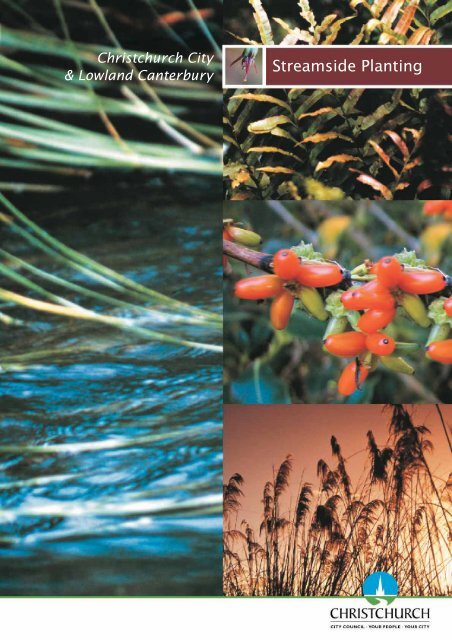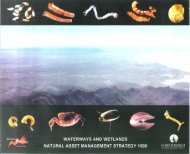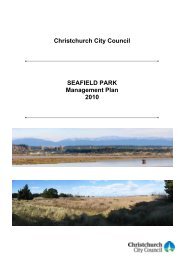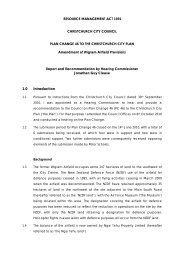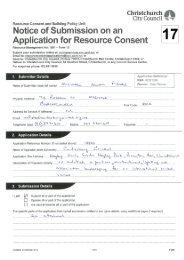Streamside Planting Guide - Christchurch City Council
Streamside Planting Guide - Christchurch City Council
Streamside Planting Guide - Christchurch City Council
You also want an ePaper? Increase the reach of your titles
YUMPU automatically turns print PDFs into web optimized ePapers that Google loves.
<strong>Christchurch</strong> <strong>City</strong><br />
& Lowland Canterbury<br />
<strong>Streamside</strong> <strong>Planting</strong>
Plant Selection <strong>Guide</strong><br />
aquatic<br />
edge of stream<br />
marsh<br />
Sedges, Rushes, Ferns<br />
and Ground Covers<br />
frost<br />
sun<br />
Tolerances<br />
shade<br />
wet<br />
dry<br />
wind<br />
grazing<br />
(once established)<br />
pondweed Myriophyllum propinquum/triphyllum l l w l m m l<br />
pondweed Potamogeton cheesemanii/ochreatus l l w l m m l<br />
raupo Typha orientalis (invades open water) l l m l m l l<br />
kapungawha, lake club rush Schoenoplectus validus/tabernaemontani l l m l m l l<br />
spike sedge Eleocharis acuta<br />
l l w l m l l<br />
pukio, tussock sedge Carex secta/virgata<br />
l l w l m l w<br />
makura Carex maorica/geminata<br />
l l w l m l l<br />
bog rush Schoenus pauciflorus<br />
l l m l m l l<br />
swamp kiokio Blechnum minus<br />
w w l l m w l<br />
swamp nettle Urtica linearifolia<br />
w l w l m m l<br />
puniu, prickly shield fern Polystichum vestitum<br />
w w l l w w w<br />
harakeke, NZ flax Phormium tenax<br />
l l m l w l l<br />
tussock rushes, wiwi Juncus gregiflorus/pallidus/sarophorus l l m l w l l<br />
umbrella sedge, upoko-tangata Cyperus ustulatus<br />
l l m l w l w<br />
gully fern, pakauroharoha Pneumatopteris pennigera<br />
m m l w l w w<br />
nini Blechnum chambersii<br />
m m l w m m l<br />
kiwakiwa Blechnum fluviatile<br />
m m l w m m w<br />
hen & chickens fern Asplenium bulbiferum<br />
m m l w m m m<br />
mata, water-fern Histiopteris incisa<br />
m m l w m m l<br />
rough pigfern Hypolepis ambigua<br />
w w l l w w l<br />
toetoe grass, toetoe Cortaderia richardii<br />
l l m w l l w<br />
kakaha, bush lily Astelia fragrans<br />
w w l w w w m<br />
pikopiko Polystichum richardii<br />
w w l w w m w<br />
ink berry, turutu Dianella nigra<br />
w l l w w l m<br />
wind grass, bamboo grass Anemanthele lessoniana<br />
w w l w w l w<br />
hounds tongue fern Microsorum pustulatus<br />
m w l w w w m<br />
tarawera, button fern Pellaea rotundifolia<br />
m w l w l m m<br />
NZ iris, mikoikoi Libertia ixioides<br />
l l l m l l l<br />
Aquatic<br />
Edge of stream<br />
Marsh<br />
A<br />
A<br />
AE<br />
AE<br />
AEM<br />
EM<br />
EM<br />
EM<br />
EM<br />
E<br />
EM<br />
EM<br />
EM<br />
E<br />
Stream Profiles - diagram<br />
Look at the generic STREAM PROFILE and decide which zone you want to plant (e.g. lower bank).<br />
Go to the top of the PLANT SELECTION GUIDE and find your chosen ZONE (e.g. lower bank).<br />
Select plants down the column. Check TOLERANCES so that you get the shade, moisture and<br />
shelter conditions just right for the plants you have selected. Every river margin is different and<br />
zones may be missing or overlapping.<br />
STREAM<br />
flood<br />
fresh<br />
low flow<br />
lower<br />
bank<br />
upper<br />
bank<br />
crest<br />
or levee<br />
as for lower<br />
terrace face<br />
backswamp<br />
lower<br />
terrace face<br />
E<br />
E<br />
Key<br />
to Plant Tolerances<br />
l very well suited<br />
w tolerant of some<br />
m not suited<br />
lower bank<br />
upper bank<br />
n<br />
n<br />
n<br />
n<br />
n<br />
n<br />
n<br />
n<br />
n<br />
n<br />
n<br />
n<br />
n<br />
upper<br />
terrace<br />
face<br />
Zones<br />
n<br />
n<br />
n<br />
n<br />
n<br />
n<br />
n<br />
n<br />
n<br />
n<br />
n<br />
n<br />
n<br />
crest or levee<br />
backswamp<br />
n<br />
n<br />
n<br />
n<br />
n<br />
n<br />
n<br />
n<br />
n<br />
n<br />
n<br />
n<br />
n<br />
n<br />
n<br />
n<br />
n<br />
n<br />
n<br />
lower terrace face<br />
upper terrace face<br />
n<br />
n<br />
n<br />
n<br />
n<br />
n<br />
n<br />
n<br />
n<br />
n<br />
n<br />
n<br />
terrace<br />
top<br />
n<br />
n<br />
n<br />
n<br />
n<br />
n<br />
n<br />
terrace top<br />
(if moist)<br />
n<br />
n<br />
n<br />
n<br />
n<br />
n<br />
Profile of a typical<br />
ephemeral stream
Shrubs and Trees<br />
frost<br />
sun<br />
Tolerances<br />
shade<br />
wet<br />
dry<br />
wind<br />
grazing<br />
(once established)<br />
mikimiki (shrub) Coprosma propinqua l l w l l l l<br />
cabbage tree, ti kouka Cordyline australis<br />
l l w l l l w<br />
mikimiki (shrub) Coprosma pedicellata l l w l w l l<br />
manuka, tea tree Leptospermum scoparium l l m l l l l<br />
kahikatea, white pine Dacrycarpus dacrydioides w l w l m w l<br />
pokaka Elaeocarpus hookerianus l l l l m l l<br />
karamu Coprosma robusta<br />
w l l l l l m<br />
mikimiki (shrub) Coprosma aff. parviflora (sp.t) l l m l w l l<br />
kohuhu, black matipo, tawhari Pittosporum tenuifolium l l w l l l w<br />
weeping mapou (shrub) Myrsine divaricata<br />
l l w l w l l<br />
turepo, milk tree Streblus heterophyllus m l l l m m w<br />
shrubby panax (shrub) Pseudopanax anomalus w w l w m w w<br />
horopito, peppertree (shrub) Pseudowintera colorata w l l l m w l<br />
kaikomako Pennantia corymbosa w l w l w w l<br />
putaputaweta, marbleleaf Carpodetus serratus m l l w m m l<br />
pigeonwood (protect from frost) Hedycarya arborea m l w w w m m<br />
hinau Elaeocarpus dentatus m l w w w m m<br />
veined mikimiki Coprosma areolata m w l w m m m<br />
round-leaved coprosma Coprosma rotundifolia m w l w m m m<br />
kotukutuku, tree fuchsia (deciduous) Fuchsia excorticata m w l w m m m<br />
poataniwha (shrub) Melicope simplex<br />
w l l w w l w<br />
rohutu, NZ myrtle Lophomyrtus obcordata w l w w w l l<br />
wheki, hard treefern (protect from frost) Dicksonia squarrosa w w l w m m w<br />
silver fern (protect from frost) Cyathea dealbata<br />
m w l w m m l<br />
matai, black pine Prumnopitys taxifolia l l w l w l l<br />
kapuka, broadleaf Griselinia littoralis<br />
w l l w l l m<br />
mapou, red mapou Myrsine australis<br />
m l l w w l w<br />
lancewood, horoeka Pseudopanax crassifolius w l l w w l m<br />
shining karamu Coprosma lucida<br />
m l l w w l m<br />
titoki (protect from frost) Alectryon excelsum m l l w w m m<br />
yellow wood Coprosma linariifolia w w l w w m m<br />
makomako, wineberry (deciduous) Aristotelia serrata<br />
m l w w m m m<br />
houhere, narrow-leaved lacebark Hoheria angustifolia l l w w l l w<br />
manatu, lowland ribbonwood (deciduous) Plagianthus regius<br />
l l w l w l w<br />
mahoe (protect from frost) Melicytus ramiflorus m l l w w m m<br />
red mikimiki Coprosma rubra<br />
w l w w w w w<br />
koromiko (shrub) Hebe salicifolia<br />
w l w w w w m<br />
totara Podocarpus totara<br />
l l w w l l l<br />
five finger, whauwhaupaku Pseudopanax arboreus m l l w w w m<br />
green mikimiki (shrub) Coprosma virescens l l w w l l l<br />
golden akeake, akiraho Olearia paniculata<br />
l l m m l l l<br />
South Island kowhai (deciduous) Sophora microphylla l l m w l l m<br />
akeake (protect from frost) Dodonaea viscosa<br />
w l w m l l l<br />
kanuka Kunzea ericoides<br />
l l m m l l l<br />
thick-leaved mikimiki Coprosma crassifolia l l w m l l l<br />
Stream Profiles<br />
- photo<br />
aquatic<br />
edge of stream<br />
lower<br />
bank<br />
crest or levee<br />
backswamp<br />
marsh<br />
lower bank<br />
upper bank<br />
n<br />
n<br />
n<br />
n<br />
n<br />
n<br />
Zones<br />
n<br />
n<br />
n<br />
n<br />
n<br />
n<br />
n<br />
n<br />
n<br />
n<br />
n<br />
n<br />
n<br />
n<br />
n<br />
n<br />
n<br />
n<br />
n<br />
n<br />
n<br />
n<br />
n<br />
n<br />
n<br />
n<br />
n<br />
n<br />
n<br />
n<br />
n<br />
n<br />
n<br />
n<br />
n<br />
n<br />
n<br />
n<br />
n<br />
n<br />
crest or levee<br />
backswamp<br />
n<br />
n<br />
n<br />
n<br />
n<br />
n<br />
n<br />
n<br />
n<br />
n<br />
n<br />
n<br />
n<br />
n<br />
n<br />
n<br />
n<br />
n<br />
n<br />
n<br />
n<br />
n<br />
n<br />
n<br />
n<br />
n<br />
n<br />
n<br />
n<br />
n<br />
n<br />
n<br />
n<br />
n<br />
n<br />
n<br />
n<br />
n<br />
n<br />
n<br />
n<br />
n<br />
n<br />
n<br />
n<br />
n<br />
n<br />
n<br />
n<br />
n<br />
n<br />
n<br />
n<br />
lower terrace face<br />
upper terrace face<br />
n<br />
n<br />
n<br />
n<br />
n<br />
n<br />
n<br />
n<br />
n<br />
n<br />
n<br />
n<br />
n<br />
n<br />
n<br />
n<br />
n<br />
n<br />
n<br />
n<br />
n<br />
n<br />
n<br />
n<br />
n<br />
n<br />
n<br />
n<br />
n<br />
n<br />
n<br />
n<br />
n<br />
n<br />
n<br />
n<br />
n<br />
n<br />
n<br />
n<br />
n<br />
n<br />
n<br />
n<br />
n<br />
n<br />
n<br />
n<br />
n<br />
n<br />
n<br />
n<br />
n<br />
n<br />
n<br />
n<br />
n<br />
n<br />
n<br />
n<br />
n<br />
n<br />
n<br />
n<br />
n<br />
n<br />
n<br />
n<br />
n<br />
n<br />
n<br />
n<br />
n<br />
terrace top<br />
(if moist)<br />
n<br />
n<br />
n<br />
n<br />
n<br />
n<br />
n<br />
n<br />
n<br />
n<br />
n<br />
n<br />
n<br />
n<br />
n<br />
n<br />
n<br />
n<br />
n<br />
n<br />
n<br />
n<br />
n<br />
n<br />
n<br />
n<br />
n<br />
n<br />
n<br />
n<br />
terrace top<br />
upper terrace face<br />
lower terrace face
Ten Steps to <strong>Planting</strong> and<br />
1. Get to know your stream,<br />
.<br />
and start to design a plan<br />
Observe your stream over<br />
different seasons, and see what<br />
opportunities there are for<br />
improvement. Consider if<br />
existing retaining walls or<br />
structures can be removed and<br />
.<br />
banks re-graded.<br />
Characterise the stretch of<br />
riverbank by referring to the<br />
stream waterway profiles in<br />
.<br />
this brochure.<br />
Check flood risk (refer to your<br />
local council if unsure) and<br />
avoid obstructing water flow<br />
.<br />
with structures or large trees.<br />
Organise resources, including<br />
labour, for site preparation and<br />
planting.<br />
Key Factors<br />
in any<br />
...<br />
restoration programme are:<br />
preparation<br />
matching plants to place<br />
on-going maintenance<br />
2. Seek advice on resource<br />
consents and your design<br />
. It is your responsibility to<br />
ensure that any work complies<br />
with local body regulations.<br />
Your local <strong>Council</strong> will be able<br />
to advise what legislation<br />
.<br />
applies to your site.<br />
A Resource Consent will be<br />
required if you are filling,<br />
building, or excavating within<br />
a defined “setback” area<br />
alongside a waterway. You may<br />
also be required to submit a<br />
planting plan to your local<br />
.<br />
council for approval.<br />
Disturbance to the bed of a<br />
river also requires Resource<br />
.<br />
Consent.<br />
If required, a landscape<br />
architect will be able to assist<br />
with the design aspects of the<br />
.<br />
site.<br />
Ensure that everyone who will<br />
be affected by any changes<br />
knows what will happen and<br />
has a chance to have their<br />
input.<br />
3. Prepare a planting plan<br />
. Identify<br />
. Compile<br />
. Space<br />
. Tussocks<br />
. The<br />
. On<br />
the different vegetation<br />
zones for your stream area as<br />
illustrated in the diagrams and<br />
photos overleaf. Consider<br />
slope, distance from stream,<br />
how damp the area is, overhead<br />
cover, how your stream flows<br />
throughout the year, and size<br />
of stream.<br />
a list of plant species<br />
for each zone identified along<br />
the stream bank according to<br />
their tolerances.<br />
plants according to the<br />
zone they belong in, and the<br />
size they grow to. You will need<br />
approximately one plant per<br />
square metre although rushes,<br />
small sedges and ferns can be<br />
planted up to three per square<br />
metre. Those plants that will<br />
develop into large trees, such<br />
as totara, matai, kahikatea, or<br />
pokaka, should be spaced at<br />
least five metres apart from<br />
others of the same kind.<br />
and reeds may be<br />
placed near the edge of the<br />
water with shrubs and small<br />
trees located on the bank above<br />
these.<br />
rush Juncus pallidus is<br />
better suited to wider or<br />
brackish waterways.<br />
higher terraces and banks<br />
plant larger trees. Plant rarer<br />
species, such as kaikomako,<br />
turepo or poataniwha, in<br />
groups to ensure crosspollination.<br />
The native aquatic plant Potamogeton cheesemanii provides<br />
habitat/food for fish and invertebrates
Restoring a Waterway for<br />
4. Order plants well in advance 5. <strong>Planting</strong> seasons 6. Prepare the site<br />
. . . Order plants well in advance of Plant species that tolerate<br />
Prepare the site well in advance<br />
.<br />
planting.<br />
wetness down to the water’s of planting. Remove invasive<br />
edge/margin during the<br />
weeds, such as convolvulus,<br />
Select a nursery specialising in<br />
summer. Other species should ivy, periwinkle, wandering willy,<br />
Canterbury sourced native<br />
be planted during autumn<br />
aluminium plant, pampas<br />
plants. Eco-sourced plants will<br />
(hardy plants) or spring (frost- grass, female grey willow (these<br />
be especially adapted to local<br />
.<br />
tender plants).<br />
have seed capsules that spread<br />
conditions and therefore more<br />
vigorously after flowering),<br />
likely to survive. They will<br />
Some ground cover plants, slow<br />
sycamore and yellow flag iris.<br />
preserve the genetic integrity growing, and/or frost sensitive<br />
.<br />
Some overhead cover may be<br />
of regional floras.<br />
species, such as ferns and tree<br />
retained temporarily as a<br />
ferns, should be planted after<br />
If plants are not being planted<br />
protection to help tender new<br />
some initial cover has become<br />
. immediately, make sure the<br />
plants establish.<br />
established and any dense<br />
containers are watered every<br />
grass has been managed – this Clear all vegetation for about<br />
day otherwise they will dry up<br />
usually occurs 2-3 years after half a metre radius around each<br />
and plants will die.<br />
the first plantings.<br />
planting position, but retain<br />
.<br />
the topsoil.<br />
If the ground is heavily<br />
compacted rip or fork up to<br />
half a metre depth.<br />
Heathcote River (Ernle Reserve) showing plant sequences associated with steep, high bank on left (tussock sedge & harakeke),<br />
low bank on right with tussocks, cabbage tree and pathway through floodplain backswamp, rising to terrace face on far right.
Natural Character<br />
7. Set out plants 8. Plant<br />
9. Fertiliser and mulch<br />
. Set<br />
. Ensure<br />
. Dig<br />
out plants in their correct<br />
zones, remembering to space<br />
plants according to how large<br />
they will grow (see stream<br />
profile diagrams).<br />
the plants have been<br />
well soaked with water and that<br />
they do not sit in the sun for<br />
a long time before planting.<br />
a hole that is deeper and<br />
broader than the container.<br />
Never cram roots into a hole<br />
too small for them.<br />
. After<br />
. On<br />
. Where<br />
. Ensure<br />
. In<br />
carefully extracting a<br />
plant from its container, prune<br />
off any entangled roots. Set<br />
the plant into a bed of soft,<br />
worked soil at the bottom of<br />
the hole, repack crumbled soil<br />
around the root mass tightly<br />
to prevent air gaps.<br />
wet sites, plant in a<br />
shallower hole so that the top<br />
of the root mass and associated<br />
soil is at ground level or, in<br />
permanently saturated<br />
conditions even slightly<br />
mounded above it. On dry,<br />
steep sites set the plant into a<br />
deep hole so that after<br />
repacking of soil there is a<br />
hollow left in the ground<br />
around the stem to catch the<br />
rain. Give the plants and the<br />
surrounding dry ground a good<br />
watering after planting.<br />
possible, stake plants<br />
so they are easily identified.<br />
plants within the<br />
waterway are well planted, and<br />
compacted around their base.<br />
moving currents it may be<br />
necessary to anchor aquatic<br />
plants to the bed of the stream<br />
with stones or other weight.<br />
. If<br />
. If<br />
. On<br />
. Do<br />
top soil has been stripped<br />
off, apply slow-release fertiliser<br />
to each plant and spread shortterm<br />
fertiliser (e.g. superphosphate)<br />
onto the ground<br />
after planting and before<br />
mulching.<br />
required, it is best to fertilise<br />
in the second year after<br />
planting, as plant roots are not<br />
developed enough to utilise<br />
fertiliser prior to this.<br />
dry sites mulch with bark<br />
chips (up to 10 cm depth),<br />
newspaper, woollen mats, or<br />
other degradable materials<br />
such as carpet underlay (not<br />
rubberised).<br />
not use mulch on wet sites<br />
or anywhere near the water<br />
flow, as mulch may restrict<br />
aeration to the plant. Mulch<br />
is also likely to be washed away<br />
and cause stream blockage.<br />
Harakeke/NZ flax (Phormium tenax), a nectarbearing<br />
plant for upper bank and floodplain
10. Establishment, watering<br />
.<br />
and on-going maintenance<br />
Make regular checks on the<br />
health of plants for several years<br />
following planting, replacing<br />
.<br />
any plants that may have died.<br />
Plants on dry banks will survive<br />
and thrive if watered regularly<br />
in summer. Plants should be<br />
weaned off watering after the<br />
.<br />
second year.<br />
Weeding around plants is<br />
essential to avoid competition<br />
and stress. This should be<br />
carried out on a monthly basis<br />
.<br />
or more frequently if required.<br />
If stock or pests (for example<br />
sheep, goats, cows, rabbits, or<br />
possums) have access to your<br />
plants, you will need to adopt<br />
some form of control. This<br />
could include fencing or<br />
.<br />
spraying plants with repellent.<br />
Do not use “weed-eaters” near<br />
trees as they can be ring-barked<br />
.<br />
and die.<br />
If spraying broad spectrum<br />
weedkillers be aware that most<br />
native plants are highly sensitive<br />
.<br />
to spray drift.<br />
Nearer the water, careful ongoing<br />
weed control is needed<br />
until the area is selfmaintaining,<br />
or until the<br />
plantings have overtopped the<br />
wild grass.<br />
Kowhai (Sophora microphylla)<br />
a nectar-bearing tree for levee<br />
and terrace face
Some design considerations<br />
. Establish<br />
. Allow<br />
. Maintain<br />
. Canopy<br />
. Use<br />
. Provide<br />
. Ensure<br />
. Seating<br />
massed vegetation in<br />
random groups along<br />
riverbanks to create wildlife<br />
habitats and interest<br />
plenty of space for large<br />
plants to grow and spread<br />
a wide band of low<br />
ground cover plants adjacent<br />
to paths<br />
trees and low ground<br />
cover allow for visual access to<br />
the watercourse. Trees take<br />
time to mature<br />
massed vegetation to<br />
screen site and where access<br />
to the waterway is not required<br />
access to waters’ edge,<br />
particularly where bank<br />
gradients are shallow<br />
planting around these<br />
points is low for visibility and<br />
safety<br />
may be provided at<br />
these points where the<br />
waterway can be seen.<br />
Benefits<br />
.<br />
of restoring your stream may include:<br />
.<br />
Increased value of property by improving privacy and aesthetic qualities<br />
Establishing a place for peaceful contemplation and enjoyment especially<br />
.<br />
within an urban environment<br />
Satisfaction of knowing that you have contributed to your local<br />
.<br />
environment by enhancing natural habitat and wildlife<br />
A sense of accomplishment that you have contributed to local biodiversity<br />
and natural character for the next generation to appreciate and enjoy.<br />
The waterways and wetlands of Canterbury are one of our greatest natural<br />
assets. Their restoration not only enhances the environment and our<br />
enjoyment of them, but allows us to leave a legacy of increased value for<br />
generations that follow.<br />
For more information<br />
<strong>Christchurch</strong> <strong>City</strong> <strong>Council</strong><br />
Phone: 941 6840<br />
Email: leisureandparks@ccc.govt.nz<br />
Refer to the website for a comprehensive reference list and more detailed information on this guide<br />
http://www.ccc.govt.nz/streamside<br />
With thanks to ecologist Dr Colin Meurk<br />
for much of the information in this<br />
guide, and Tanya Cathel-Black for the<br />
graphic design and majority of the<br />
photography.<br />
Thanks to Waimakariri District <strong>Council</strong><br />
for their financial contribution.


